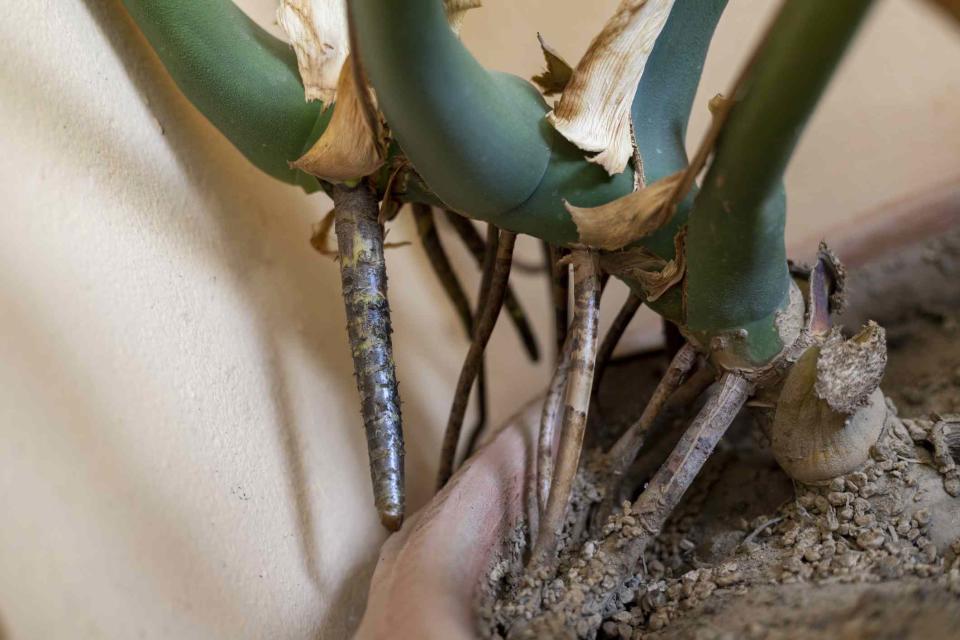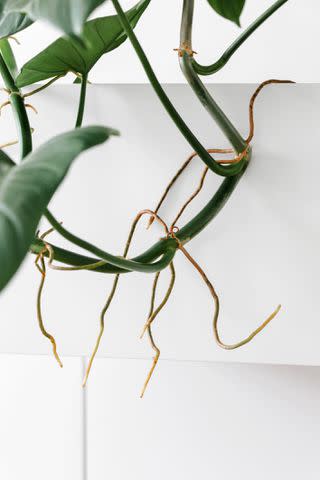5 Things to Know About Aerial Roots
What are they and what should you do about them?

Bilal photos / Getty Images
Reviewed by Kathleen Miller
Have you ever looked at your plant and wondered about those long things growing out the stem? Well, those are aerial roots, roots that develop on a plant above the surface of soil or water while the rest of the plant roots are submerged.
“Essentially, aerial roots are root tissue a plant produces up out of the soil,” says Justin Hancock, a horticulturist, from Costa Farms. “Many common and trendy varieties of houseplants produce them, including many monstera, pothos, and philodendron." "In the right environment, they’re hard to miss," notes Hancock. "On one of my monstera, for example, a couple of the aerial roots are about four feet long.”
Here are five main things to know about aerial roots.
1. Aerial Roots Help Plants Climb

SEE D JAN / Getty Images
One of the reasons why aerial roots grow is for climbing. “If you think about how a lot of climbing houseplants grow, including English ivy, golden pothos, and Monstera deliciosa, the roots help keep these vines secure as they scale up trees, walls, or other structures,” says Hancock.
Placing a trellis or a moss pole near these plants encourages the aerial roots to latch onto it with their aerial roots. Providing support for the aerial roots is especially important if you have plants
growing near a wall because otherwise, they are likely to start latching onto the wall, causing paint to chip and other damage.
2. Aerial Roots Help Strengthen Plants
"Other species, including many ficus, have aerial roots that drop into the soil, which strengthens the plant and helps provide support for the branches. Banyans are a classic example of this,” notes Hancock. Banyan is a fig tree variety that develops additional trunk-like stems from aerial roots. “These plants are very sturdy; the aerial roots help keep them grounded so they don’t fall over."

Ignacio Palacios / Getty Images
Banyan tree with aerial roots3. Aerial Roots Absorb Moisture
“Epiphytic plants, such as many tillandsias, as well as many orchids, use their aerial roots to absorb moisture from the air, rain, or fog/mist,” explains Hancock. Humidity-loving plants in a bathroom may sprout long aerial roots to capture extra moisture.
4. What Kinds of Plants Grow Aerial Roots?
“A wide variety of plants produce aerial roots if environmental conditions are right,” says Hancock. Climbing aroids like monstera, pothos, philodendron, rhaphidophora, or scindapsus, are popular houseplants with aerial roots. But you can also commonly find aerial roots on other vines like English ivy and climbing hydrangea. Plants that grow aerial roots to absorb moisture range from orchids to staghorn ferns.
You’ll also see aerial roots develop on a number of plants that make baby plantlets—like spider plant, strawberry begonia, and mother of thousands. According to Hancock, in a humid environment, a lot of Ficus species develop aerial roots, including Ficus benjamina and Ficus lyrata.
Keep your eyes open around your houseplants—you may start to notice aerial roots in many of your plants.
How to Create a Moss Pole for Your Indoor Plants
5. What Should I Do (And Not Do) to Aerial Roots?
There are several things you shouldn’t do to your plants that have aerial roots. The appearance of aerial roots does not mean that a plant needs repotting. “Because we’re used to seeing roots under the soil, don’t conclude aerial roots mean a plant is rootbound,” says Hancock. “Repotting to bury aerial roots typically isn’t beneficial to the plant."
Also, don’t remove the aerial roots of climbing plants, unless they are growing out of bounds. While trimming aerial roots won’t directly harm the plant, it makes it vulnerable to plant pests and diseases because it creates an open wound. Removing the aerial roots may also backfire, as it often triggers more aerial root growth.
If you must trim the aerial roots of your plant, follow the same basic rules as with other pruning:
Do it outside the active growing season, which varies from plant to plant.
Use clean, sharp, sterilized shears, secateurs, or pruners.
Cut the aerial roots back as close to the stem as possible without damaging the stem.
Frequently Asked Questions
Is it possible to propagate a plant from aerial roots?
Some plants can be propagated by air layering their aerial roots. Others, such as spider plants, produce small baby plants with roots on them that can be replanted. But beyond these exceptions, it is not possible to propagate a plant with only aerial roots. The aerial roots don’t have nodes on them to encourage new root growth, neither in water nor in soil. You’ll need a stem cutting with a node for plant propagation.
Should you bury aerial roots?
It is optional and depends on the plant. If a plant is tall and likely to topple over as it continues to grow, burying the aerial roots in the soil helps support the plant and makes it stronger.
Is it OK to cut off aerial roots on orchids?
Aerial roots on orchids should never be trimmed or removed, it robs the plant of its ability to absorb moisture and nutrients and inevitably kills it. All orchid roots are aerial roots, even if they are not all suspended in the air but buried in bark or sphagnum moss.
Read the original article on The Spruce.

